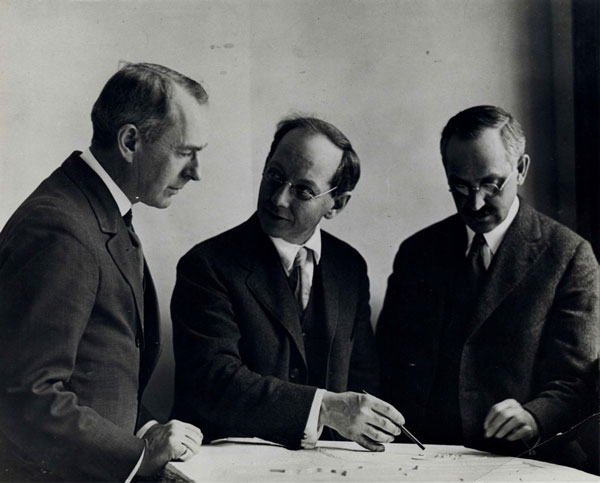Park History
Explore the different histories of Memorial Park
A Brief History of Memorial Park
From its beginning, Memorial Park has existed through collaborative partnerships of public and private interests. Explore its history.
The Olmsted Brothers
From the moment that Ninah Cummer made contact with the Olmsted Brothers landscape design firm, Memorial Park was destined for national significance.
Sculptor Charles Adrian Pillars
Charles Adrian Pillars, a nationally known sculptor, was selected by the Citizens Committee in 1920 to design the memorial he named Spiritualized Life.
Memorial Park Master Plan
The Memorial Park Association’s most ambitious project is still in the planning stages. In 2013 the board adopted a Master Plan, based on the recommendations of Atlanta landscape architect David Sacks. The goals of the Master Plan are designed to restore the luster of the park, enhance its appeal to today’s visitors, and pass along intact to future generations the unique beauty and character of this spot.
Photo courtesy of Mark Krancer
Timeline of Historical Events
As Memorial Park approaches its centennial in 2024, take time to peruse the nearly 100-year timeline of the park’s beginnings, its decline some 50 years later, and its resurrection as Jacksonville’s premier public park following the restoration plans undertaken by Memorial Park Association.
The Spirit of Victory
In April 2017, Memorial Park Association released a video telling the story and significance of Memorial Park. Shot in high-definition, it is truly a masterpiece that showcases Memorial Park like nothing else ever has.

 From its beginning, Memorial Park has existed through collaborative partnerships of public and private interests. In November 1918, George Hardee of the Rotary Club of Jacksonville put forth a proposal for a memorial to honor Floridians who died in service during “The Great War,” known today as World War I, which was to be paid for by the citizens of Greater Jacksonville and dedicated in a new public park. The following year, the City of Jacksonville purchased approximately six acres along the St. Johns River in the neighborhood district of Riverside for $125,000. Hardee led efforts to form the Citizens Committee to plan the park’s development, along with various civic leaders and philanthropists, such as Morgan Gress, Ninah Cummer, Edith Gray, and Mary Cline. In two years they raised $52,000, commissioned nationally famed local-area sculptor Charles Adrian Pillars to create a memorial to Florida’s war dead, and hired the renowned Olmsted Brothers to design the park.
From its beginning, Memorial Park has existed through collaborative partnerships of public and private interests. In November 1918, George Hardee of the Rotary Club of Jacksonville put forth a proposal for a memorial to honor Floridians who died in service during “The Great War,” known today as World War I, which was to be paid for by the citizens of Greater Jacksonville and dedicated in a new public park. The following year, the City of Jacksonville purchased approximately six acres along the St. Johns River in the neighborhood district of Riverside for $125,000. Hardee led efforts to form the Citizens Committee to plan the park’s development, along with various civic leaders and philanthropists, such as Morgan Gress, Ninah Cummer, Edith Gray, and Mary Cline. In two years they raised $52,000, commissioned nationally famed local-area sculptor Charles Adrian Pillars to create a memorial to Florida’s war dead, and hired the renowned Olmsted Brothers to design the park. From the moment that Ninah Cummer made contact with the Olmsted Brothers landscape design firm in Brookline, Massachusetts, Memorial Park was destined for national significance. The Olmsted Brothers were renowned for designing national and city parks, private residences, campuses, libraries, and state capitol buildings, with projects ranging geographically from all corners of the continental United States. The firm was run by stepbrothers John Charles Olmsted (1852-1920) and Frederick Law Olmsted, Jr. (1870-1957), sons of the preeminent landscape architect Frederick Law Olmsted (1822-1903), who famously designed Central Park in Manhattan, New York and the emerald necklace of Boston and is considered by many to be the inventor of the modern urban park. Both brothers were also founding members of the American Society of Landscape Architects and helped start the first professional training program for landscape architects at Harvard.
From the moment that Ninah Cummer made contact with the Olmsted Brothers landscape design firm in Brookline, Massachusetts, Memorial Park was destined for national significance. The Olmsted Brothers were renowned for designing national and city parks, private residences, campuses, libraries, and state capitol buildings, with projects ranging geographically from all corners of the continental United States. The firm was run by stepbrothers John Charles Olmsted (1852-1920) and Frederick Law Olmsted, Jr. (1870-1957), sons of the preeminent landscape architect Frederick Law Olmsted (1822-1903), who famously designed Central Park in Manhattan, New York and the emerald necklace of Boston and is considered by many to be the inventor of the modern urban park. Both brothers were also founding members of the American Society of Landscape Architects and helped start the first professional training program for landscape architects at Harvard.
 Charles Adrian Pillars (1870-1937) was a mature, accomplished, and nationally known sculptor before the Citizens Committee selected him in 1920 to design the memorial he named
Charles Adrian Pillars (1870-1937) was a mature, accomplished, and nationally known sculptor before the Citizens Committee selected him in 1920 to design the memorial he named